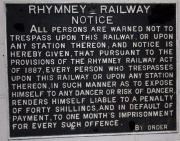
of Cardiff
The Rhymney Railway was virtually a single stretch of main line, some fifty miles in length, by which the Rhymney Valley was connected to the docks at Cardiff in the county of Glamorgan, South Wales. [1]
The aim of the railway was to gain access to the large iron works and collieries at the extreme north of the Valley. Short extensions, connecting with other railways, gave the Rhymney routes to take its (largely mineral) traffic to the Midlands and the North of England, or opened up connections to collieries and iron works. Some of those routes were worked jointly with other companies, particularly the London and North Western Railway (LNWR).
The section from Rhymney to Nantybwch, giving access to the London and North Western Railway (LNWR). This section was worked jointly by the two companies April 1871 and was known as the Nantybwch and Rhymney Railway.
1854 The company was incorporated.
1908 The company owned 39 miles of line, and partly owned 29.5 miles more. [2]


